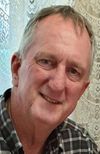"The Bombing of Darwin 1942" by John 'Rowdy' Wylie
Every year, thanks to John "Rowdy" Wylie, the AnArt4Life blog features a special tribute in the form of a painting to commemorate ANZAC DAY and also REMEMBRANCE DAY in November.
This year Rowdy's special acknowledgement focuses on the bombing of Darwin, Northern Territory, Australia in 1942.
Rowdy explains to us that his painting of the The Bombing of Darwin 1942 is in quadriptych format so that each panel could tell a story. Below we see the painting in Rowdy's Shed in its final stages before completion.
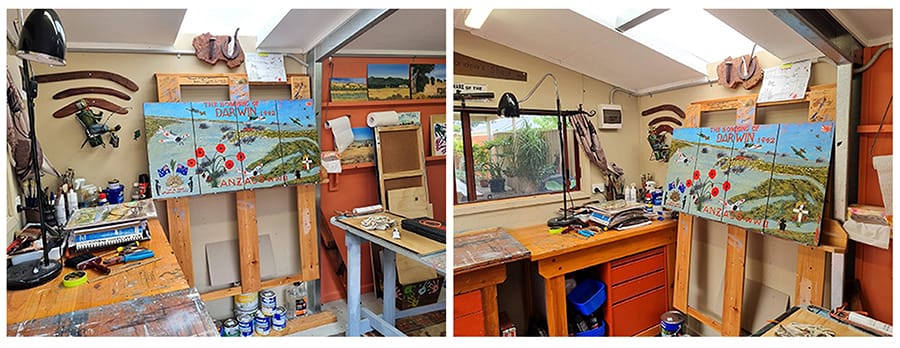
Rowdy opens his heart, mind and studio door to describe how the painting came into being:
For some time I have been thinking of a suitable composition for this years “ANZAC DAY” – 2024. So I decided on a particular ANZAC battle - one close to Home!! For me “The Bombing of Darwin” in 1942 was “Australia’s Pearl Harbour”!!!
The inspiration for this WW2 “Documentary War Composition” is the incredible historic story about the “surprise” invasion by the Japanese on the Australian Home Land at the time of “world conflict and war”. This event followed on from the earlier Japanese bombing of America’s “Pearl Harbor”.
Also my thoughts were about the future vulnerability and security of our Nation’s northern regions… particularly in regards to the current “unrest” in world relations and possible threats of future conflict!!
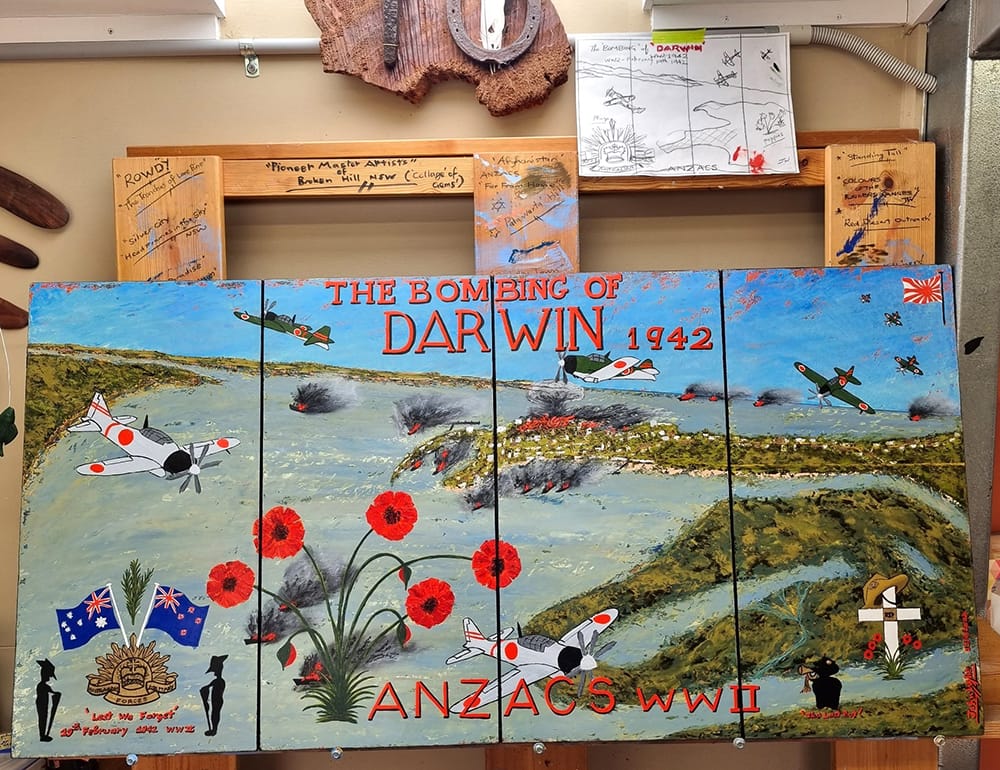
Composition Details:
Title: “THE BOMBING OF DARWIN” 1942
“Australia’s Pearl Harbour”
WW2 – “The Bombing of Darwin” – 19th February 1942
(“Documentary War Painting”)
Artist: John “Rowdy” Wylie
Medium: Oil on Timber Board – (Quadriptych Format)
Size: W120cms x H60cms
Date: 2024
WW2 February 19th – 1942
“Darwin”…. is a strategic port on Australia’s northern coastline and has been for decades… but in the mid-1930’s a major military build-up began… By 1942 the population had more than tripled… with around 7,000 troops stationed in Darwin Township…
The military build-up prior to the Second World War triggered significant up-grades to the Stuart Highway. It was then transformed from a rough dirt track to a major supply road. Also in 1940.. a booming economy saw the opening of two new banks in the commercial district of Darwin.1
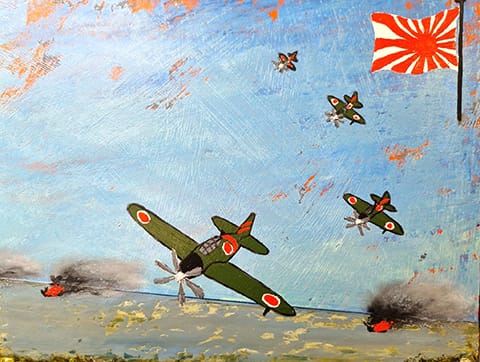
The bombing of Darwin was a wakeup call to Australia as Rowdy explains:
The Battle of Darwin:
Also referred to as – Australia’s “Pearl Harbour”… The bombing of Darwin was the single most powerful attack by a foreign power on Australia… About 255 aircraft attacked the town destroying everything… mainly air fields and the harbour. The Japanese strategy was to avoid contest in their future invasions of Timor and Java.
Darwin was lightly defended and the Japanese inflicted heavy losses upon the Allied Forces… The urban areas of Darwin suffered some damage and there were civilian casualties… 2
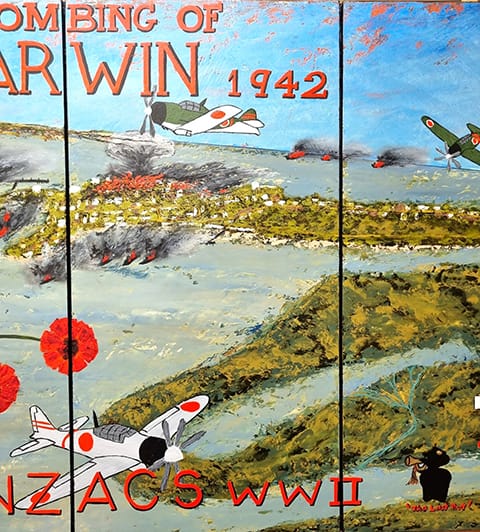
The Bombing of Darwin:
At 9.58am on 19th February 1942...27 Japanese bombers accompanied by zero fighter escorts began the air raid on the Australian mainland… their mission was to destroy the Allied Military bases in Darwin. From Darwin.. the Allies could contest the Japanese invasion of near-by islands of Timor and Java…
The Japanese mounted two air attacks on this day… The first attack concentrated on the town centre and the Darwin Harbour. Many buildings and ships were destroyed.. including the Darwin Post Office… the Police Barracks and the Office of the Administration of the Northern Territory.
More than 250 people… both service personnel and civilians died in Darwin on 19th February 1942…
Between 19th February 1942 and 12th November 1943 the Japanese mounted 97 attacks across northern Australia impacting on Broome… Wyndham.. Port Headland… and Derby in Western Australia. 3
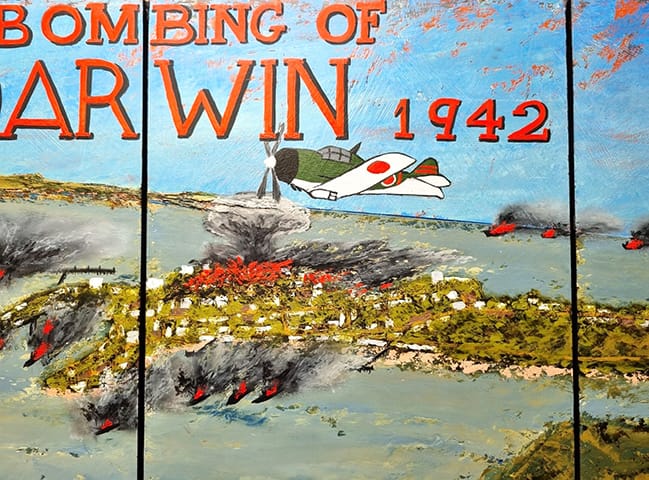
Remembering Darwin - 1942:
The first air wave of Japanese planes lasted for 40 minutes. The aircraft bombed and machine gunned the Darwin township and harbour. They sank 47 ships in the harbour including a cargo ship with 200 depth charges… which exploded as the ship lay beside the wharf…
Darwin’s defense was in-adequate… a few anti-aircraft guns… though constantly in action were overwhelmed… Ten United States “Kittyhawk” fighters were all destroyed… while in the air or taking off…
Eighty minutes later the second wave of Japanese bombers arrived to continue the attack… this time concentrating on the inland RAAF base…
The air raids cost the Japanese no more than ten aircraft…4
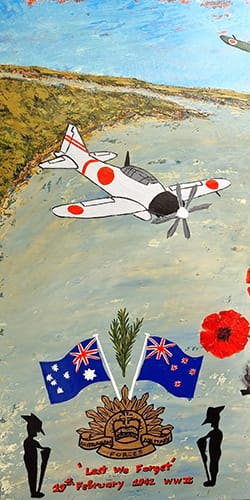
Australians will always remember the events of “The Bombing of Darwin” on 19th February 1942 and those who died in them…
Here at the “Roll of Honour” of the Nations War Memorial… “We Will Remember Them” 4
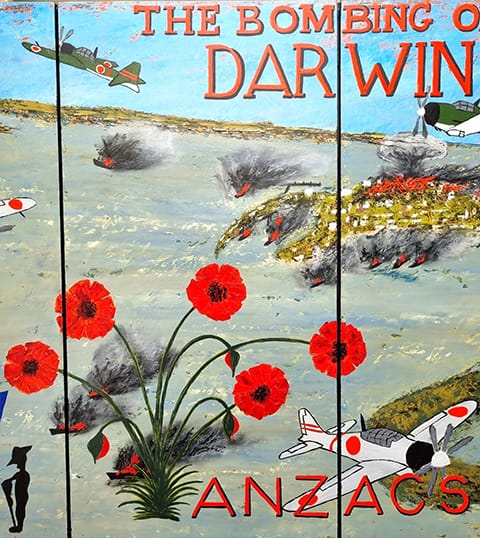
Rowdy aims for his ANZAC paintings to be educational for future generations… and for people to pay homage and remembrance to our ANZACS who defended so bravely both our nations… Australia & New Zealand… in the defense of Australia & Papua New Guinea WW2…
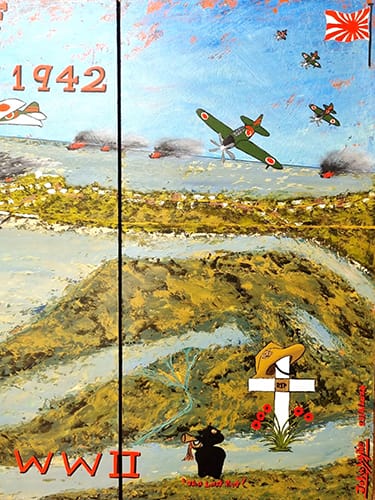
Rowdy explains that he has a personal connection to the war as it affected Darwin in that:
My Uncle - Clifford West… flew “missions” out of Darwin with the RAAF during WW2 gathering “intelligence” about the Japanese movements around Australia’s northern islands. My Uncle corresponded by letter to his wife (my Auntie) back in Adelaide with the letters all written in their unique “code” due to the Australian “defense security measures” of the “service personnel’s” secret locations…
When we think about the past wars that in particular Australia and New Zealand have been involved in many of us tend to concentrate our memory and reflection on the service people directly involved in the conflict - forgotten in the main the families and friends left back at home trying to live their lives as normally as they could whilst constantly thinking about their loved ones fighting in lands, most often far away.
After “Singapore” was taken by the Japanese and “Darwin” was bombed… many of our ANZACS were relocated from the Middle East War Zone and moved to the War Front of Papua New Guinea to defend Australia from the Japanese invasion. This is where the famous battles of the Coral Sea, Kokoda and Milne Bay (May-September 1942) took place which can be read about by clicking here. Anne's father Brigade Major Ernest King Newman was part of the Kododa Track campaign. Rowdy's uncle Pte. Maxwell Kenneth Wylie 2/10th Rifle Infantry – AIF was also part of the conflict in PNG. After the death of Maxwell’s brother Floyd Wylie in Syria… Maxwell was re-deployed from the Middle East Campaign to the PNG Campaign to defend the 3x Milne Bay – “Air Strips” which were under intense attack by the Japanese….
We share these connections as a reminder that the personal connections with our present and past conflicts are never far from home.
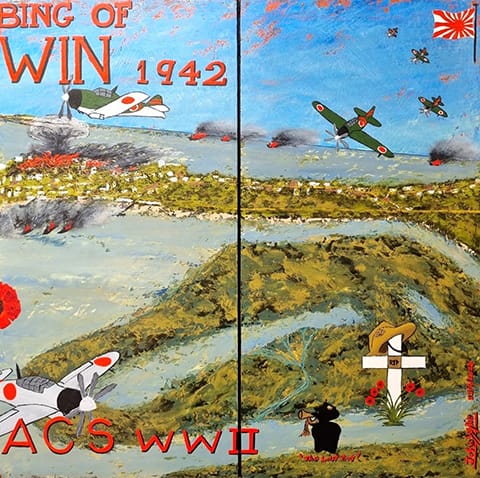
As a very proud South Australian, Rowdy has added to today's ceremonial post some information about Port Pirie’s Airport SA – RAAF Involvement with the defense of Darwin & Northern Australia
Brief History:
The “die” was cast for the RAAF in WW2 with the signing of the “Empire Air Training Scheme” - Agreement in December 1939… Under this scheme the RAAF would set up an extensive training organization to supply aircrew for the rapidly expanding Royal Air Force…
The non-pilot aircrew were categorized as Observers/Navigators.. Wireless Operators & Air Gunnery Schools (WAGS) & Bombing & Gunnery Schools (BAGS):
Three BAGS were established..
1/ BAGS Evans Head NSW August 1940
2/ BAGS Port Pirie SA June 1941
3/ BAGS West Sale Vic January 1942
2BAGS: Bombing & Gunnery School Port Pirie SA
This site was established due to the available space.. good flying conditions all year round.. and adjacent coastal sea-scape suitable for bombing & gunnery “ranges”…
The Port Pirie site had been extensively developed.. such that it could accommodate hundreds of troops & dozens of aircraft… It has been said that around 20,000 people were trained in these “rolls” through the BAGS Schools from 1941 to 1946.
23 RAAF trainees were killed while undergoing 2BAGS Training in Port Pirie during this time…
During the 1942 Bombing of Darwin & the ongoing bombing of the northern townships & defense bases… the majority of troops were deployed to the north by train from Adelaide via Port Pirie to Alice Springs then transported by road to the north…
Current Day:
In 1947 the Port Pirie Airport reverted to civilian use… The WW2 “Bellman Hanger” is still standing at the airport and in good condition… it remains in use by light aircraft based at the airport…
Recently (2023) the City of Port Pirie announced a commemorative project at the Port Pirie Aerodrome – A “Military Historical Mural” for the WW2 “Bellman Hanger”… South Australian Mural Artist – Sam Brooks is renowned for his extensive portfolio of public art and has been commissioned with his assistant Mark Harding to create a stunning mural for the side of the “Hanger”….
The Mural Aims:
• To focus on the community of Port Pirie & their involvement in the “Empire Air Training Scheme”
• The three panels will tell a story of pilots & WAAF engineers… wartime maps… & the iconic training planes..5
In Remembrance of ANZAC DAY 2024
“Lest We Forget”
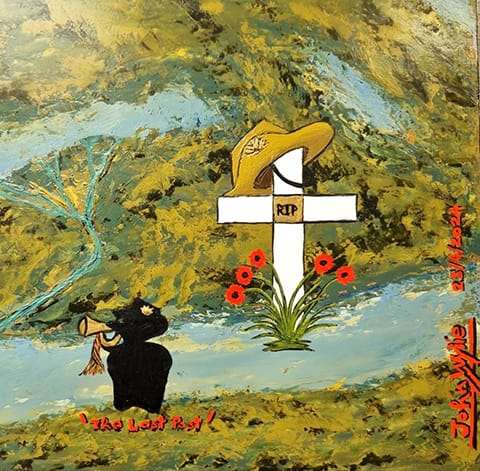
A very special thank you to Rowdy Wylie for sharing his wonderful Remembrance Paintings with us twice a year so that our subscribers and social media followers can reflect on Australia's involvement in the numerous conflicts which have occurred in the past 100+ years.
Rowdy paints in the Naive Art Style and therefore his recreations contain strong narrative elements which aid the viewer in learning more about the war arena Rowdy has chosen to paint.
Rowdy is a member of the Victor Harbor Regional Gallery of artists and earlier this year together we presented the history of the growth of the Art Community in this area. If you missed these posts please use our search tool with the tag Victor Harbor to find these past posts.
Credit
1. Library & Archives of the Northern Territory
2. en.wikipedia.org
3. ANZAC Portal- https://anzacportal.dva.gov.au/
4. The Australian War Memorial- https://www.awm.gov.au/
5. History Group SA - Aviation Museum Inc:, The Empire Has an Answer by Tony James Brady, Port Pirie Regional Council SA, Wikipedia – Port Pirie Airport, Jeff Kenyon – (Curator) Port Pirie RSL “Military Museum”.

